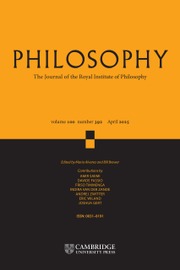Article contents
Sock Puppetry in Online Communication
Published online by Cambridge University Press: 11 October 2024
Abstract
This paper concerns sock puppetry, a practice which involves an individual communicating under multiple pseudonymous identities in a manner that makes it seem as though these personas are distinct conversational participants. I provide a definition of sock puppetry that is more narrow than other definitions, allowing it to be distinguished from related phenomena. I then analyse some of the ways in which sock puppetry can interfere with social tools we use for establishing trust within an online community, evaluating a speaker's credibility, and generally deciding who and what to believe.
- Type
- Research Article
- Information
- Philosophy , Volume 99 , Special Issue 3: The Philosophy of Online Communication , July 2024 , pp. 461 - 478
- Copyright
- Copyright © The Author(s), 2024. Published by Cambridge University Press on behalf of The Royal Institute of Philosophy
References
- 1
- Cited by



